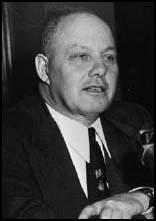Difference between revisions of "AFL/President"
(Created page with "{{employment |wikipedia= |start= |interests= |constitutes= }} {{SMWDocs}} ==References== {{reflist}} {{Stub}}") |
(unstub) |
||
| Line 1: | Line 1: | ||
{{employment | {{employment | ||
|wikipedia= | |wikipedia= | ||
| − | |start= | + | |start=1886 |
| + | |end=1955 | ||
| + | |successors=AFL–CIO/President | ||
|interests= | |interests= | ||
|constitutes= | |constitutes= | ||
| + | |image=George Meany.jpg | ||
| + | |image_caption=[[George Meany]] also became President of the merged [[AFL-CIO]] after 1957. Meany attended [[Le Cercle]]. | ||
| + | |description=The President of the labor union [[AFL]] until the merger in 1955. | ||
}} | }} | ||
| + | The President of the '''American Federation of Labor''', which in 1955 merged to become '''The American Federation of Labor and Congress of Industrial Organizations''' (AFL–CIO), the largest federation of unions in the United States. | ||
| + | |||
| + | ==History== | ||
| + | The '''American Federation of Labor''' ('''A.F. of L.''') was a national federation of [[labor unions in the United States]] that continues today as the [[AFL–CIO]]. It was founded in [[Columbus, Ohio]], in 1886 by an alliance of craft unions eager to provide mutual support and disappointed in the [[Knights of Labor]]. [[Samuel Gompers]] was elected the full-time president at its founding convention and was re-elected every year except one until his death in 1924. He became the major spokesperson for the union movement.<ref>https://www.britannica.com/topic/American-Federation-of-Labor</ref> | ||
| + | |||
| + | The A.F. of L. was the largest union grouping, even after the creation of the [[Congress of Industrial Organizations]] (CIO) by unions that were expelled by the A.F. of L. in 1935. The A.F. of L. was founded and dominated by [[craft unionism|craft unions]], especially in the building trades. In the late 1930s, craft affiliates expanded by organizing on an [[industrial unionism|industrial union]] basis to meet the challenge from the CIO. The A.F. of L. and the CIO competed bitterly in the late [[1930s]] but then cooperated during [[World War II]] and afterward. In [[1955]], the two merged to create the [[AFL–CIO]]. | ||
| + | |||
| + | ==Successor== | ||
| + | {{FA|AFL–CIO/President}} | ||
{{SMWDocs}} | {{SMWDocs}} | ||
==References== | ==References== | ||
{{reflist}} | {{reflist}} | ||
| − | |||
Latest revision as of 03:17, 5 March 2024
 | |
| Start | 1886 |
| End | 1955 |
| Successors | AFL–CIO/President |
| The President of the labor union AFL until the merger in 1955. | |
The President of the American Federation of Labor, which in 1955 merged to become The American Federation of Labor and Congress of Industrial Organizations (AFL–CIO), the largest federation of unions in the United States.
History
The American Federation of Labor (A.F. of L.) was a national federation of labor unions in the United States that continues today as the AFL–CIO. It was founded in Columbus, Ohio, in 1886 by an alliance of craft unions eager to provide mutual support and disappointed in the Knights of Labor. Samuel Gompers was elected the full-time president at its founding convention and was re-elected every year except one until his death in 1924. He became the major spokesperson for the union movement.[1]
The A.F. of L. was the largest union grouping, even after the creation of the Congress of Industrial Organizations (CIO) by unions that were expelled by the A.F. of L. in 1935. The A.F. of L. was founded and dominated by craft unions, especially in the building trades. In the late 1930s, craft affiliates expanded by organizing on an industrial union basis to meet the challenge from the CIO. The A.F. of L. and the CIO competed bitterly in the late 1930s but then cooperated during World War II and afterward. In 1955, the two merged to create the AFL–CIO.
Successor
- Full article:
 AFL–CIO/President
AFL–CIO/President
- Full article:
An Office Holder on Wikispooks
| Name | From | To | Description |
|---|---|---|---|
| George Meany | 1952 | 1955 | Arranged the merger with the CIO |